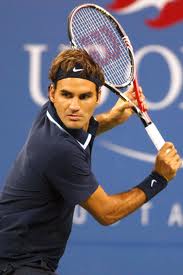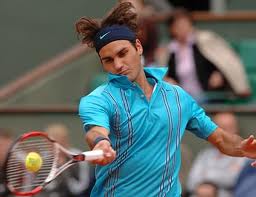

Let's study these two pictures of the GOAT in action. Besides his impeccable preparation and picture perfect timing can someone tell me if they notice something that stands out?! I'll give you a hint...the head. Still not enough? OK, how about this - the eyes. Specifically, which eye is in front on the backhand and which eye is in front on the forehand?
After studying the picture for a few seconds, you will notice that the right eye is in front on the backhand while the left eye is in front on the forehand. Immediately before the contact point, let's try to guess which eye "sees" the ball first? I think that we can all agree that, under most circumstances, the eye that's in front (linearly speaking) of the other picks up the moving object first. Ocular dominance, sometimes called eye dominance, is the tendency to prefer visual input from one eye to the other. According to the article from Science Daily, "[i]n normal binocular vision there is an effect of parallax, and therefore the dominant eye is the one that is primarily relied on for precise positional information. This may be especially important in sports which require aim, such as archery, darts or shooting sports."
Why is this important for tennis players? Well, for one thing, much like baseball players, tennis players are engaged in a hitting activity. As suggested in the psyched.com article, a study of several University of Florida baseball players suggested that the best players were cross-eye dominant (i.e., batted right; but had a dominant left eye - the eye that saw the ball first): "College varsity level baseball players are twice as likely as the general population to have crossed dominance. The incidence of central eye dominance is considerably higher than the general population. The best hitters were centrally eye dominant or crossed eye-hand dominant." See also this abstract.
Much like hand-dominance, eye dominance is both innate but can also be trained. For example, Nadal is a natural righty but he has learned to play tennis left-handed. With respect to eyes, a player may very well be naturally right-eye dominant but by practicing a certain way - for example, hitting thousands of forehands (on one side of the body) and only a couple of hundred backhands (on the other side of the body) - it is possible that the player will train the left eye to take over. This could be detrimental to the backhand since, on the other side of the body, the left eye may be "further back".
As a result, it's possible that the player may be seeing the ball - and striking it - early on the forehand but late on the backhand (i.e., hitting it only when the ball has entered the field of vision for the left eye). If you suspect that this may be the case - for example, if you find yourself striking certain shots "off the front foot" and others "off the backfoot" - then, perhaps, your stroke is not to blame... maybe you've practiced a certain shot so much that it has had an effect on the eyes which, in turn, have affected when and how you hit another shot. I mention this because, often times, I see juniors hitting forehands in a 4:1 ratio to backhands (backhands are, sometimes, a mere "afterthought" if the forehand doesn't work out). There is at least some risk that disproportionate training - intentionally or inadvertently - on one side of the body may lead to an imbalance in perception which can have a detrimental effect on your strokes (and what you can do with the ball - i.e., someone who sees the ball late and hits it late might be unable to go down the line very well). The good news is that it seems that occular dominance (or balance) can be restored. Some baseball players use eye patches when doing their batting-cage practice (see The Baseball Coaching Bible by Jerry Kindall and John Winkin, p. 138) so there's no reason why a tennis player with a similar issue can't do the same (i.e. put an eye patch over one eye in order to train the non-dominant eye to see the ball sooner) on the ball machine or backboard.